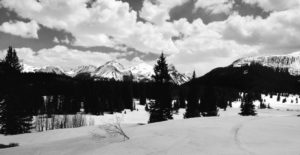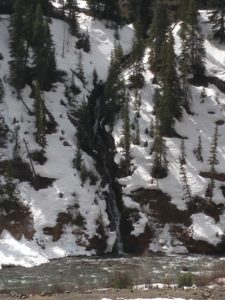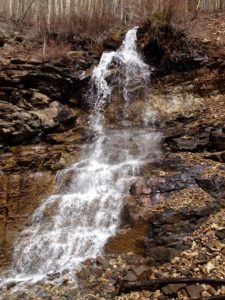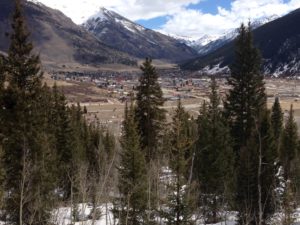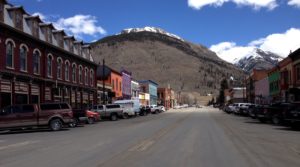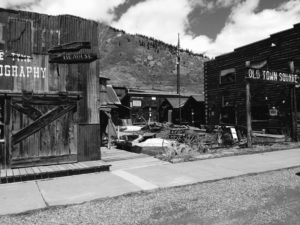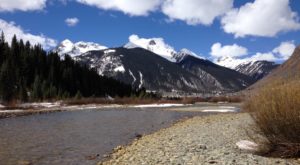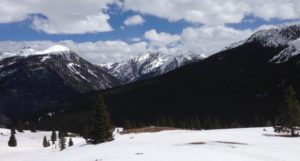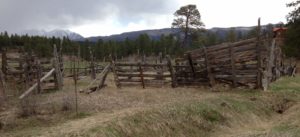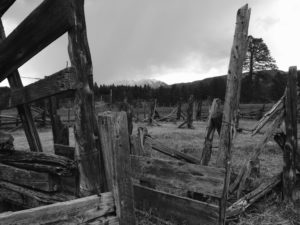My plan today was a drive up to Silverton, return, and then a bike ride down into the old part of Durango. The old narrow gauge train doesn’t start to run up all the way to Silverton until “sometime in early May”.
In the Animas River Valley going north, what I remember as mostly small ranch and grazing land has been supplanted by a couple of RV parks, one of which I’m camped in, a few mobile home courts, a couple of gated communities with golf courses, and a lot of yuppified homes scattered 20 miles up the valley from Durango. There is one large grazing area still left right at the head of the valley.
It feels great to come off the high desert plateau of Utah and return to the forested mountains of SE Colorado.
And this time of year there is the added bonus of lots of water running everywhere.
Silverton is an old mining town, one of the oldest in Colorado. It’s a little quiet now. Most of the busyness is people getting there shops ready for “the season”. One of the reasons I’ve always been attached to Silverton is the only paved street in town is the main street. All of the others, and there are only a few, are still dirt. The back streets are an odd mixture of abandoned houses, new rustic looking ones, and junk yards.
The Animas River flows out of these mountains, through Silverton, down through Durango and into New Mexico where it joins with the San Juan River which joins the Colorado River in Utah. 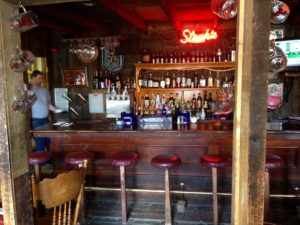
It also flows right near my newest favorite bar, the Pickle Barrel. And oh look, here he comes with my Italian sausage soup.
There are two mountain passes on the way to Silverton, Coal Bank and Molas. Both are comparatively benign although Molas tops out at just a couple of feet under 11,000. The next one, on the way to Ouray is Red Mountain Pass. I didn’t drive all the way over to Ouray, but I did go up to the top of Red Mountain. It was like visiting a friendly old rival. I’ve seen the best and worst that Red Mountain can throw at you. This road, as much as any, defines for me the phrase “not for the faint of heart”. I have history with this road. And it’s not so much the precipice sections as it is the weather and conditions it can throw at you without warning. I don’t know if they still do it, but back in the day when the high avalanche fields would build, they might stop you on the mountain for a couple of hours while they shot artillery shells into the snow build up.
Today it’s very quiet. Except for brief moments of passing vehicles there is no sound. No wind, the clouds are barely moving. That almost never happens at 11,000 feet.
Once I drove off Red Mountain down to Ouray entirely in first gear. A trip of usually 20-25 minutes took me, if memory serves, almost two hours. About one and half miles above Ouray I came upon a flatbed semi that was backing back down the mountain. He had reached the limit of consistent traction he could get, and with no place to turn around, was returning to Ouray in reverse. And folks he wasn’t backing down a straight road. He and I were the only ones up there and I stopped to ask him if there was anything I could do to help. He had been trying to raise someone on the radio and was hoping for a patrolman to come up. I told him I’d find him one. When I was almost there I met a highway dept. sand truck and a sheriff’s SUV on the way up to do a little escort work. Yup, Red Mountain Pass and I have history and I’ve always kept most of it to myself. But I digress.
The mountains are beautiful. I love them.
And I didn’t forget the old wood.
I never did make that bike ride. I stayed up on the mountain too long and besides, it was drizzling when I got back to camp. So I went and had Mexican and margaritas instead.
